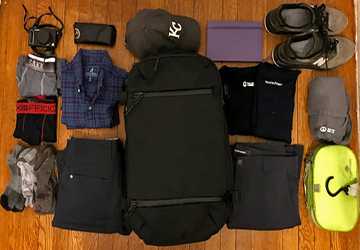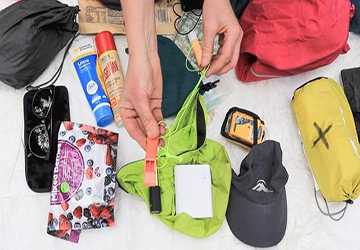Backpacking through nature allows us to disconnect from technology and daily stresses. Immersed in beautiful scenery, the only things that matter are the essentials in our pack and the trail ahead. However, hauling multiple heavy items quickly fatigues the body and mind. Before your next adventure, implement these packing hacks to keep your load light. Not only will your outdoor experience drastically improve, but you'll also be able to journey farther. Learn actionable tips to pare your pack down to only what you need without sacrificing necessities.

Top 4 Lightweight Backpacking Packing Hacks
When embarking on a backpacking trip, every ounce counts. Let's discuss four tricks to minimize the weight of your pack while still being prepared.
Audit Your Existing Gear
The first step to lightweight packing begins at home, assessing what's already in your closet. Analyze each item, asking – do I need this for my specific trip? Be objective and realistic about necessities; often, our eyes are more significant than our outdoor needs. For example, camp chairs seem comforting but are heavy luxuries better left behind. Sleeping pads sufficiently cushion and insulate. Use your best judgment if the weather demands extra equipment.
Leverage Multi-Use Gear
Ingenuity allows certain items to transcend singular functions, transforming into versatile tools. Equipment like sporks, bandanas, hiking poles, and carabiners tackle various jobs. A bandana offers a cleansing handkerchief, towel, pot grabber, head wrap, and sling. Carabiners securely fasten gear externally, lessening internal bulk. Repurposing equipment condenses items without forfeiting necessity. Alternatively, share when possible. For example, coordinate communal tents or stoves with hiking partners. Consolidating equipment reduces duplicates. The ounces saved combine significantly with lightning packs. Ingenuity and cooperation enable travelling farther and faster.
Opt for Low-Tech When Possible
Thru-hike veterans understand that cutting-edge technology often unnecessarily adds to pack weight. They evaluate each high-tech item by asking whether a low-tech option would sufficiently serve the same purpose. Does a standard headlamp provide ample hands-free lighting? Can an essential water bottle replace a complex filtering system? Lightweight backpacking requires carrying only the necessities. Simple, time-tested tools typically satisfy without the elevated weight. Invest limited funds into improving major gear pieces like backpacks, sleeping bags, and hiking shoes, considering future adventures. Save on ancillary items when simpler, lighter substitutions work.

Scrutinize Food Choices
Common dehydrated ingredients provide nutritious, lightweight options when meal planning compared to canned, bottled, or jarred foods. Ounce for ounce, repackaged meals like beans, lentils, pasta, rice, quinoa, nuts, seeds, nut butter, and jerky offer more energy and fullness. Supplement with lightweight comfort foods like hard cheese, chocolate, or cider packets for motivation to continue. Carry minimal cooking tools; for example, forgo pots and pans if meal ingredients require hot water. Alternatively, use cold soaks to skip carrying stoves and fuel altogether. Calculate daily rations for each meal, snack, and hot beverage need. This prevents carrying excess bulk while still fueling miles.
Conclusion
Implementing these packing hacks enables escaping deep into nature unburdened by extraneous gear. Travel farther and faster to immerse fully in the rejuvenating freedom of the trails. Not to mention more room for trip memories like photographs, journals, or geological specimens found along the way. Share your lightweight packing tips below in the comments!
FAQs
Q: What are some other ways I can reduce pack weight?
Ans: Strip off any unnecessary straps, tags, or packaging on gear. For example, remove retail tags or cut excess buckled straps. Share more oversized communal items like tents or stoves with hiking partners. Rent bulky gear after arriving at your destination when possible. Choose lightweight footwear, clothing, and rain protection.
Q: What are the lightest backpacking shelter options?
Ans: Tarp tent systems provide the lightest shelters while offering bug and weather protection. Look for tarps made of silnylon or cuben fibre under 20 ounces and bivy sacks under 2 pounds. Please keep it simple, and for solo trips, ultra-light. Just ensure breathability. Ultralight one-person tents around 3 pounds also work well.
Q: What food planning tips help keep your weight down?
Ans: Calculate exact rations to prevent carrying excess. Repackage meals in lightweight ziplock bags, then further contain these in odour-proof bags to organize while saving weight. Choose nutritionally dense snacks that satisfy hunger in small servings - nuts, seeds, nut butter, jerky or lightweight energy bars. Carry a few comfort food favourites for motivation.